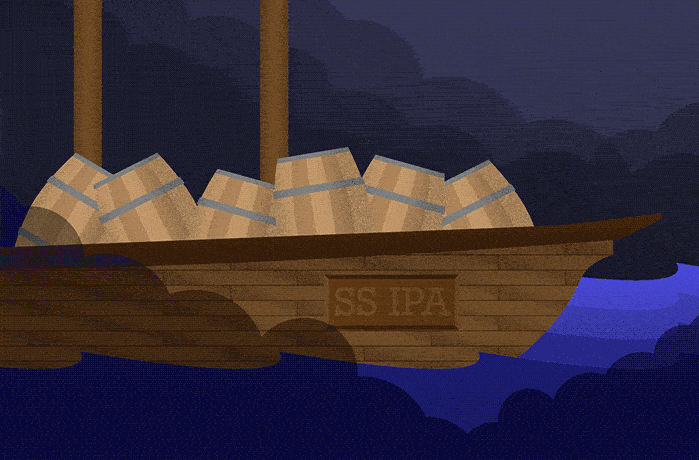The India Pale Ale (IPA) would benefit from a Snopes-like website devoted to disproving the cock-and-bull that surrounds the style. Among the more prevailing myths is that the over-hopped IPA was specifically invented to survive the arduous voyage from England to India during the 18th and 19th centuries.
“I’ve recreated Mycenaean beer, Viking beer, Ancient Peruvian beer [and] Revolutionary American beers, but recreating the original India Pale Ale was by far the most difficult one for me,” says Travis Rupp, a beer archaeologist who teaches courses on the subject at the University of Colorado’s Boulder campus.
The Rocky Mountain town is also home to Avery Brewing Co. Until recently, Rupp helmed its research & development, where he spearheaded a project called Ales of Antiquity.
“With IPA, I had to figure out how to make a beer [by] recreating the conditions in London [during the 1700s], then simulate shipping it to India,” says Rupp. But certain archaic techniques were certainly going to be off the table at a modern brewing facility.
One, for instance, is the practice of coke-firing. This made coal usable as malting fuel, which offered more control over the process during the mid-1600s. It burned more cleanly and allowed for a lighter roast compared to wood or peat, which would have darkened the malt and imparted a smoky taste.
By the turn of the 18th century, the technique allowed for the creation of “pale ales” in England. These beers were shipped to Madras, India, as early as 1717. In 1784, these pale ales were advertised in the Calcutta Gazette. That’s pretty solid proof that the English made successful beer shipments to India long before they loaded the brews with tons of hops.
At the time, dark porters would have been the more prominent beer style sent to India. Not only were they more robust, they were the dominant beer style in London at the time and what British soldiers were used to consuming back home.

According to beer historian Ron Pattinson, between 1849–57, the British East India Company ordered 23,511 hogsheads (64-gallon barrels) of pale ale and a whopping 46,363 hogsheads of porter.
“[B]ut this heavy, viscous and semi-sweet libation suited cool British weather better than oppressive tropical humidity,” wrote Nicholas J. Hamlin of porter in his paper, Britain, Bengal, Burton, and Beer.
A six-month -, if not two-year-long boat ride to India and other warmer climates—and tack on up to a year of storage time as well—made English exporters realize they might need more hops than usual to preserve these beers.
How the rumor started
George Hodgson is the best-known exporter from that era. He’s often lazily credited as “inventing” the IPA. He began to brew beer in east London in 1752. His Bow brewery was positioned close to East India’s dock, where trade ships would load up with goods.
Hodgson started to export his beer, and he was one of the few English brewers that would extend credit on beer that might not be sold for 18 months.
“Hodgson was taking the exact same beer he sold in London, and for transport to India, he would dry-hop the barrels,” says Rupp, who says Hodgson even crafted a special spring-loaded, flapped device that he could insert and stamp down whole-cone hops in hogshead.

Like many historians, Rupp believes Hodgson’s and other ur-IPAs of the time would have derived from what was known as October beer, or “malt wine.” These were essentially imperial bitter ales produced in the fall from freshly harvested hops and then aged for two to three years. But they were “super, super expensive” to brew, says Rupp. There’s a reason that it was mostly officers who would drink them in India. The cheap porter was left for the hoi polloi.
And yet…
“[There’s] absolutely zero evidence to support the idea that Hodgson’s beer was formulated or invented specifically for exportation to India,” writes acclaimed American brewer Mitch Steele in his 2013 book, IPA: Brewing Techniques, Recipes and the Evolution of India Pale Ale.
This type of highly hopped pale ale would exist for many decades before it would be labeled an “India pale ale.” The first written appearance of “India pale ale” was found in an Australian newspaper from 1829.
By then, Burton-on-Trent, a market town 135 miles north of London, had become the epicenter of this style of exported beer, now produced by brewers like Bass and Allsopp.
William Molyneux’s 1869 book, Burton-on-Trent: Its History, Its Waters and Its Breweries, was the first to credit Hodgson with inventing “India ale,” which may have burnished a legacy that perhaps he didn’t merit.
Recreating the original IPA today
As for Rupp, he would create 1752 IPA, which denotes the year that Hodgson opened his brewery. Rupp replicated water from the Thames, dry-hopped the beer with nearly double the amount of East Kent Goldings he would have used in a modern brew and fermented it in used English oak casks.
Periodically, Rupp even periodically rocked the barrels and fluctuated their storage temperature over the next three months to simulate the arduous journey to India.
“God, I gotta get people to buy this—what if it tastes like shit?” Rupp says that he remembers thinking at the time. It breaks all the rules of the days fresh, fruity, hazy IPAs so popular today. “I thought the beer was going to be awful, but it was actually quite nice.”
Last Updated: May 8, 2023















